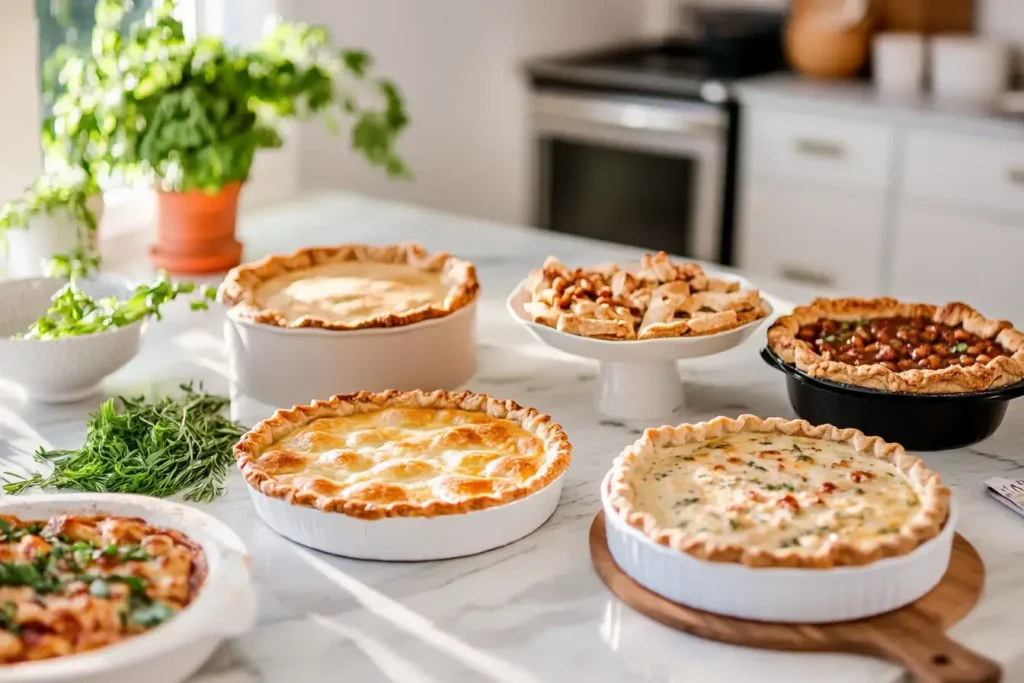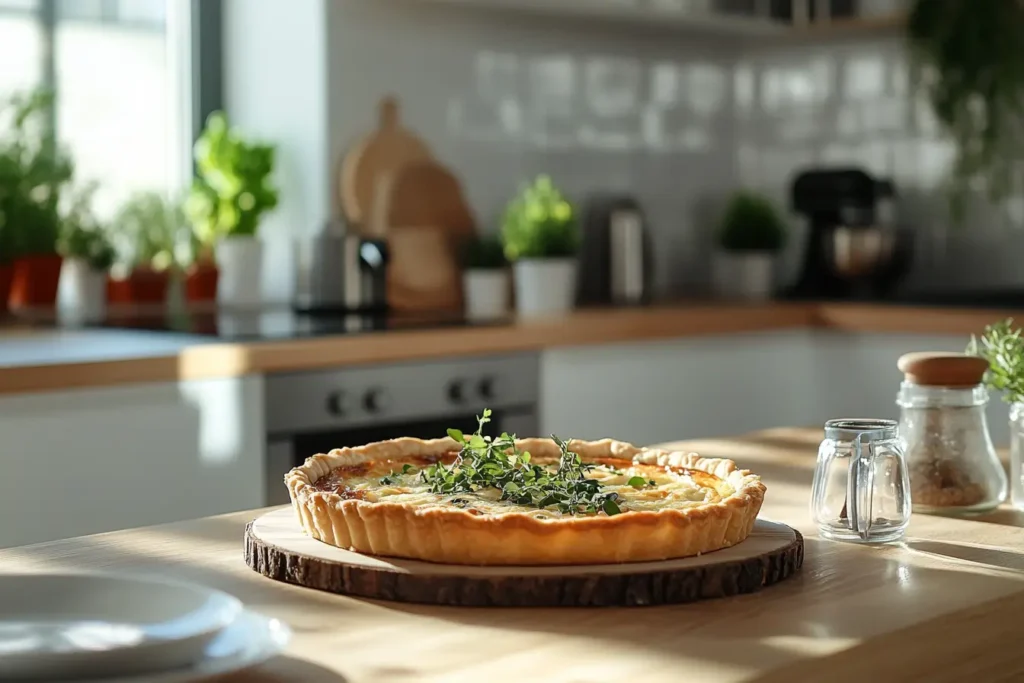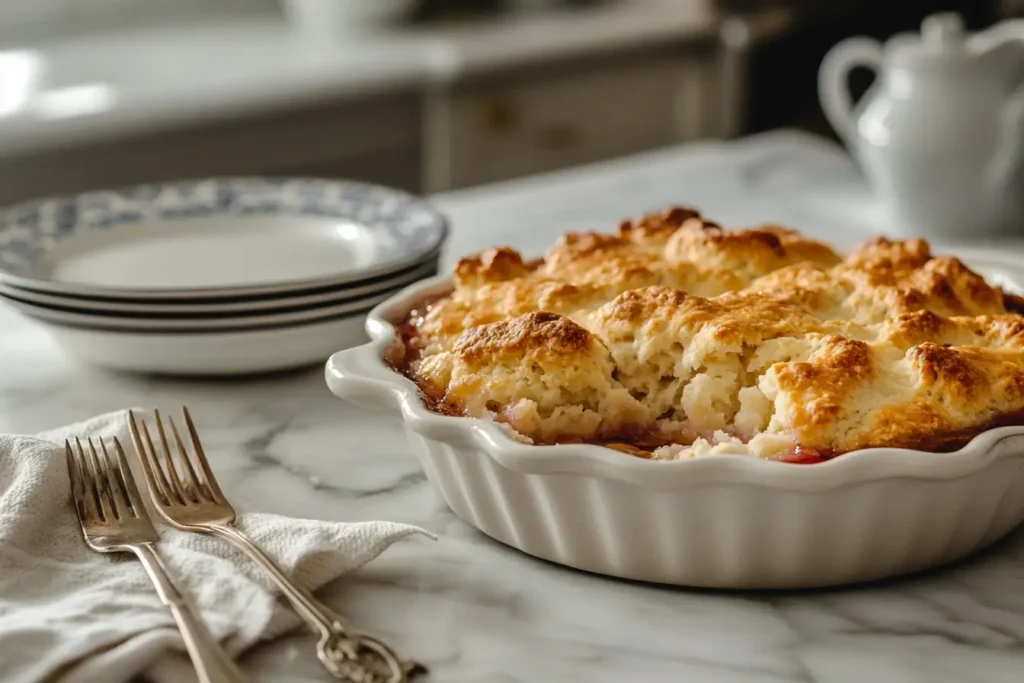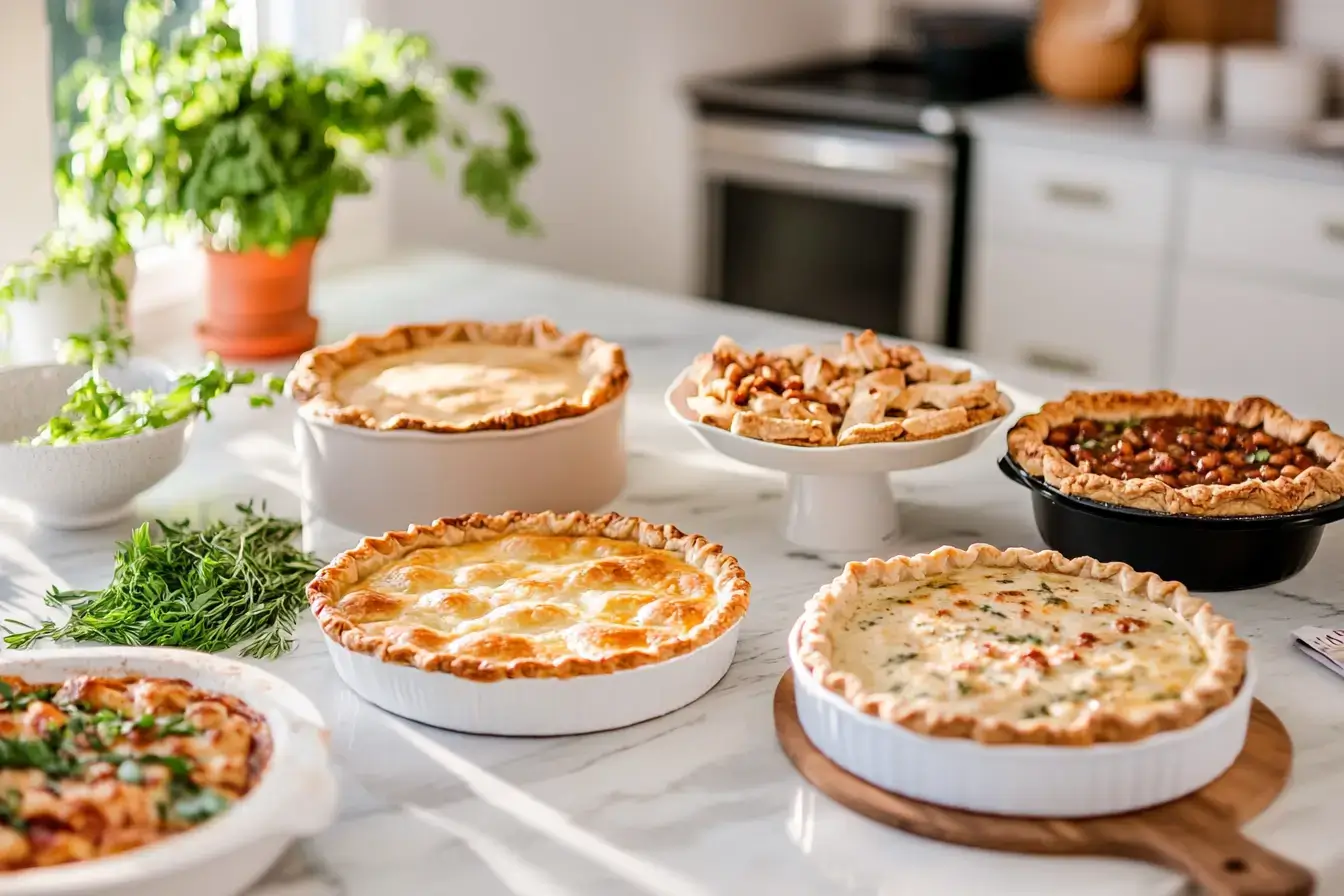
When you think of a pie, a flaky crust often comes to mind. But what about a pie without bottom crust? These crustless delights, such as quiches, cobblers, and pot pies, focus on showcasing the filling, offering a unique twist to traditional recipes. Let’s dive into the world of bottomless pies and explore their charm!
Introduction to Pie Without Bottom Crust
Picture this: a beautifully baked dish that skips the bottom crust entirely but still manages to serve up all the goodness you’d expect from a pie. These “bottomless” pies break the rules in the best way possible. Whether it’s to save time, focus on the filling, or reduce carbs, skipping the bottom crust isn’t just a shortcut—it’s a choice that leads to some truly iconic dishes.
But let’s clear something up. When we talk about pies without bottom crusts, we’re not throwing tradition out the window. Instead, we’re embracing a twist that focuses on creativity and flavor. Whether savory or sweet, these dishes prioritize the star of the show: the filling.
Why are bottomless pies so popular? For starters, they’re incredibly versatile. They can be as simple or fancy as you like, perfect for a quick family meal or an elegant dinner party. They’re also easier to make since you don’t have to fuss over rolling out a bottom crust. Let’s be honest—sometimes less is more!
Common Names for Pie Without Bottom Crust
The beauty of a bottomless pie lies not just in its simplicity but also in the variety of names it’s known by. Depending on the ingredients and preparation style, these pies go by different names. Let’s explore a few:
Quiche: The Elegant Classic
If you’ve ever been to a brunch or a fancy café, you’ve probably seen a quiche on the menu. A quiche is a savory custard pie made with eggs, cream, and all sorts of delicious add-ins like cheese, vegetables, or meats. While quiches often have a crust, many recipes skip it, letting the rich, creamy filling take center stage.
What makes quiches so special? They’re like the little black dress of the food world—perfect for any occasion. Want a light breakfast? Quiche. Need a hearty lunch? Quiche. Planning a fancy dinner? You guessed it—quiche. Plus, they’re ridiculously customizable, so you can get as creative as you like.
Cobblers: The Comfort Food Hero
Cobblers are the epitome of comfort food. These sweet (and sometimes savory) pies ditch the bottom crust in favor of a biscuit or crumble topping. Imagine a warm peach cobbler fresh out of the oven, its golden topping soaking up the juices of the bubbling fruit beneath. It’s like a hug in dessert form. 🍑
But cobblers aren’t just for dessert. Savory versions, like chicken cobblers with cheesy biscuit tops, are just as satisfying. They’re proof that skipping the bottom crust doesn’t mean sacrificing flavor or heartiness.
Pot Pies Without a Base
Pot pies are another classic that works perfectly without a bottom crust. In fact, many chefs prefer it this way because it lets the creamy, savory filling take center stage. Whether it’s chicken, beef, or vegetarian, a pot pie with just a top crust can still deliver all the comfort and flavor you crave.
Characteristics of a Pie Without Bottom Crust
So, what sets bottomless pies apart from their traditional counterparts? Let’s break it down.
The Filling Takes Center Stage
Without a bottom crust, the focus shifts entirely to the filling. And honestly, isn’t that the best part? Whether it’s a rich custard, a savory stew, or a juicy fruit mixture, the filling is where the magic happens. Bottomless pies celebrate this by giving the filling all the attention it deserves.
Take a quiche, for example. Without a bottom crust, the creamy custard gets to shine, highlighting the flavors of the added ingredients like spinach, cheese, or bacon. Similarly, a cobbler’s topping acts as the perfect contrast to the luscious fruit filling beneath.
Textures That Stand Out
The absence of a bottom crust doesn’t mean these pies are lacking in texture. In fact, they often have a delightful contrast of textures. A cobbler’s biscuit topping, for instance, offers a crisp, crumbly texture that complements the softness of the fruit filling. Quiches, on the other hand, are smooth and creamy, with any added ingredients providing a bit of bite.
Why They’re So Popular
Let’s face it: not everyone is a fan of crust. Some find it too heavy, others think it takes away from the filling, and some are just trying to cut down on carbs. Bottomless pies solve all these problems while still delivering the essence of a pie.
“Skipping the bottom crust isn’t just practical—it’s a way to elevate the filling and create something truly special. Who says you need a base to have a great pie?” 🌟
Popular Types of Pie Without Bottom Crust

Now that we’ve covered the basics, let’s dive into the delicious world of bottomless pies. Here are some of the most popular types, each with its own unique charm.
Quiche: The Classic Bottomless Pie
Quiches are often associated with French cuisine, but their appeal is universal. At its core, a quiche is a savory custard made from eggs and cream, baked until it’s firm but still creamy. It’s typically baked in a pie dish and can include a variety of fillings, from vegetables to meats to cheeses.
What makes quiches so versatile is their adaptability. You can go as fancy or simple as you like. A classic quiche Lorraine, made with bacon and cheese, is always a hit. But if you’re feeling adventurous, try adding caramelized onions, roasted red peppers, or even smoked salmon. The possibilities are endless.
And here’s a fun fact: while quiches are often associated with brunch, they’re actually perfect for any meal. Pair a slice with a fresh salad for lunch, or serve it with roasted vegetables for dinner. Who knew something so simple could be so sophisticated?
Cobblers: Sweet and Savory Versions
Cobblers are the ultimate comfort food, and their charm lies in their simplicity. Unlike traditional pies, cobblers skip the bottom crust and focus on a juicy filling topped with a biscuit or crumble topping. They’re like the cozy sweater of desserts—warm, satisfying, and perfect for chilly evenings.
When it comes to sweet cobblers, peach and berry are classic choices. But savory cobblers are just as delicious. Imagine a chicken cobbler with a creamy filling and a cheesy biscuit topping. It’s like a pot pie, but with a twist.
And let’s not forget the versatility of cobblers. You can make them in a big dish to share with the family or in individual ramekins for a more personalized treat. Either way, they’re guaranteed to impress.
Popular Types of Pie Without Bottom Crust (Continued)

Let’s pick up where we left off and explore more types of bottomless pies that have earned their place in kitchens around the world.
Savory Pot Pies Without a Base
Pot pies are synonymous with comfort food. Traditionally, they’re made with a golden, flaky crust that wraps around a rich, savory filling of meats, vegetables, and creamy sauces. But here’s the thing: you don’t always need the bottom crust for it to be a pot pie masterpiece.
In fact, pot pies without bottom crusts are often more convenient and just as satisfying. The filling remains the star of the show, bubbling with flavor beneath a perfectly baked, golden top crust. Some versions even use puff pastry, which rises and crisps up beautifully, creating a satisfying crunch with every bite.
Pro Tip: To avoid soggy tops, brush the pastry with an egg wash before baking. It gives the crust that perfect golden-brown sheen.
Tarts vs. Bottomless Pies: What’s the Difference?
Now, you might wonder: aren’t tarts just fancy pies? Well, kind of, but not exactly. While traditional tarts usually have a crust (typically just on the bottom), there are crustless versions that focus entirely on the filling.
Crustless tarts are a lot like quiches but tend to be lighter and slightly more delicate in texture. They’re perfect for showcasing fresh ingredients like seasonal vegetables or fruits, making them a hit at summer picnics and elegant gatherings.
Why Do Some Pies Skip the Bottom Crust?
So, why exactly would someone skip the bottom crust? It seems like an important part of a pie, right? Well, not always! Here’s why some pies go bottomless:
Practical Reasons: Easier and Faster Baking
Let’s face it—making pie crust from scratch can be time-consuming. Rolling it out, making sure it doesn’t break, fitting it into the pie dish… it’s an art form that requires patience and practice.
Skipping the bottom crust simplifies the process and saves time. If you’ve ever thrown together a quick cobbler for a last-minute dinner party, you know how convenient it is to focus on the filling and the topping without worrying about the base.
Healthier Options: Cutting Back on Carbs
Another reason bottomless pies are popular is their appeal to health-conscious eaters. A traditional pie crust is delicious, sure, but it’s also loaded with carbs and fats. For those looking to cut back, a pie without a bottom crust offers a lighter, healthier alternative while still delivering plenty of flavor.
Quote to Remember: “A bottomless pie lets you indulge without the guilt. It’s proof that delicious food doesn’t have to come with a heavy calorie count!” 💪
Creative Culinary Choices
Sometimes, chefs and home cooks alike choose to go crustless purely for creative reasons. They want to highlight the filling in all its glory without the distraction of a crust. It’s like putting the spotlight on the main character in a play—the filling gets to shine and take center stage.
Challenges in Making Pie Without Bottom Crust
While bottomless pies sound like a dream, they do come with their fair share of challenges. Here are some of the most common ones you might face:
Filling Consistency Issues
One of the biggest challenges in making a bottomless pie is ensuring the filling has the right consistency. Without a bottom crust to hold everything together, the filling needs to be firm enough to hold its shape when sliced.
For example, in a quiche, if the egg custard isn’t thickened properly, you’ll end up with a runny mess. And nobody wants a pie that falls apart the moment you try to serve it.
Balancing Flavor in a Pie Without Bottom Crust
Let’s not forget that pie crust adds flavor to a dish. It’s buttery, flaky, and slightly savory, providing a perfect contrast to sweet or rich fillings. Without it, you need to make sure the filling itself is flavorful enough to stand on its own.
Fun Tip: Adding herbs and spices to the filling can enhance its flavor and compensate for the absence of a crust.
Soggy Toppings in Cobblers and Pot Pies
If you’ve ever baked a cobbler, you know that getting the topping just right can be tricky. Sometimes, the juices from the fruit filling soak into the topping, leaving it soggy instead of crisp and golden.
The same issue can arise with pot pies. If the top crust isn’t baked long enough or is too thin, it can turn soft and doughy instead of flaky and delicious.
Solutions to Common Problems with Pie Without Bottom Crust
Luckily, every problem has a solution! Here are some tips and tricks to overcome the challenges of making bottomless pies.
Tip 1: Use Cornstarch or Flour to Thicken Fillings
If your pie filling is too runny, adding a thickening agent like cornstarch or flour can help. For fruit pies and cobblers, a tablespoon or two of cornstarch mixed into the filling will work wonders. For savory pies like quiches, a bit of heavy cream or cheese can help thicken the custard.
Pro Tip: Make sure to let your pie cool for at least 10-15 minutes before slicing. This allows the filling to set and makes for neater slices.
Tip 2: Boost Flavor with Herbs, Spices, and Cheeses
Without a crust to add flavor, you’ll want to make sure your filling is packed with deliciousness. Fresh herbs like thyme and rosemary work beautifully in savory pies, while cinnamon, nutmeg, and vanilla enhance sweet pies.
Cheese is also your best friend in quiches. A sharp cheddar or creamy goat cheese can add depth and richness to the dish, making every bite a delight.
Tip 3: Keep Toppings Crispy
To avoid soggy cobbler toppings, pre-bake the topping separately before adding it to the pie. This helps it crisp up and creates a beautiful contrast to the juicy filling below.
For pot pies, make sure to use a thick top crust and brush it with an egg wash before baking. This not only gives it a beautiful golden color but also helps it stay crisp and flaky.
Are Pies Without Bottom Crusts Truly Pies?
This question has sparked debates in kitchens and food forums alike. To some, a pie without a bottom crust is like a car without wheels—functional but missing a key component. For others, the filling is what defines a pie, and the crust is just a supporting player. Let’s explore both sides of the argument.
The Case for Yes
Supporters of bottomless pies argue that these dishes fulfill the essence of what a pie represents: a delicious filling served in a dish. Whether it’s a savory quiche or a fruity cobbler, the heart of the dish remains the same.
The Case for No
Traditionalists, on the other hand, believe that a pie must have a crust to be considered a pie. After all, isn’t the phrase “as American as apple pie” rooted in the idea of a flaky, golden crust? Without it, the dish edges closer to a casserole or pudding.
So, what’s the verdict? Honestly, it’s all about perspective. The culinary world is ever-evolving, and there’s room for every interpretation of a pie—crust or no crust.
Popular Cultural and Regional Influences
Bottomless pies are as diverse as the cultures they come from. Here’s a glimpse into how different regions put their own spin on these dishes:
French Quiches
The French perfected the art of the quiche, often making it with or without a crust. The filling typically combines eggs, cream, and cheese, along with regional ingredients like smoked salmon or Gruyère cheese.
American Cobblers
In the southern United States, cobblers are a beloved dessert. Whether peach, apple, or berry, these sweet treats are often served warm with a dollop of vanilla ice cream.
British Puddings
While not quite the same as a pie, British savory puddings—like Yorkshire pudding or steak and kidney pudding—share similarities with bottomless pies in their focus on hearty fillings.
FAQs About Pie Without Bottom Crust
1. Can you have pies for breakfast?
Absolutely! Bottomless pies like quiches or crustless breakfast casseroles are fantastic morning options. For more breakfast pie inspiration, check out Can You Have Pies for Breakfast?. 🥧
2. What’s the best way to ensure your custard pie doesn’t fall apart?
The secret lies in the filling’s consistency. Using cornstarch or flour as a thickener ensures that your custard holds its shape. Explore more tips in Custard Pies: Another Name. 🍮
3. What are some variations of pies without bottom crusts?
Beyond quiches and cobblers, egg-based pies and crustless casseroles are excellent options. Dive into more ideas with Egg-Based Pies. 🥚
4. How do cobblers differ from galettes or traditional pies?
Cobblers are defined by their juicy fillings and biscuit-like toppings, while galettes have a rustic, open-faced crust. To learn more, visit Difference Between Pie and Galette. 🍑
Conclusion: The Timeless Appeal of Pie Without Bottom Crust
So, what is a pie with no bottom crust called? It could be a quiche, a cobbler, or even a pot pie with just a top crust. Whatever the name, these dishes offer endless possibilities for creativity and flavor. Bottomless pies aren’t just a shortcut—they’re a celebration of the filling, allowing ingredients to shine in ways that traditional pies sometimes don’t.
Whether you’re baking a cheesy quiche for brunch, a sweet cobbler for dessert, or a hearty pot pie for dinner, remember this: a pie without a bottom crust is still a pie, as long as it’s made with love. ❤️
So, why not try one today? You might just discover a new favorite!
If you’d like to see more recipes and tips, let me know, or feel free to explore related dishes on Zeen Recipes for more culinary inspiration! 😊

